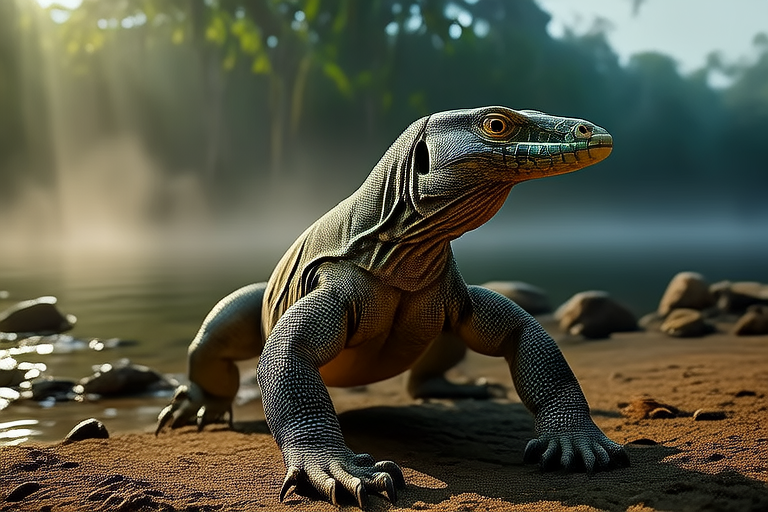Exploring the Mysterious World of Water Monitors: A Complete Care Sheet
Introduction
The water monitor (Varanus salvator) is one of the largest lizards in the world, known for its impressive size, agility, and adaptability. Native to Southeast Asia, these semi-aquatic reptiles have a unique combination of physical traits that make them fascinating pets. Water monitors can grow up to 3 meters (9.8 feet) long and possess powerful limbs, sharp claws, and a muscular tail, which they use both for swimming and defense. Their diet consists of a wide variety of prey, making them opportunistic feeders. Despite their intimidating appearance, water monitors are intelligent creatures capable of learning to interact with humans. However, due to their large size and specific care requirements, they are not recommended for novice reptile owners.
Habitat Setup
Tank Size
Water monitors require spacious enclosures that mimic their natural environment. The minimum recommended tank size for an adult water monitor is 16 square feet, with at least 6 feet of length and 4 feet of height. Juveniles can be housed in smaller enclosures but will need to be upgraded as they grow. It’s important to provide ample space for swimming, basking, and climbing. Ensure that the enclosure has a secure lid or screen top to prevent escapes.
Lighting
Proper lighting is crucial for the health of your water monitor. Full-spectrum UVB lighting is essential for vitamin D3 synthesis, which aids in calcium absorption. Use a high-quality UVB bulb designed for reptiles and place it within 12 inches of the basking area. Replace the bulb every six months, even if it still appears functional, to ensure optimal output. Additionally, provide a heat lamp to create a basking spot with a surface temperature of 95-105°F (35-40°C). Install a thermostat to maintain consistent temperatures.
Temperature and Humidity
Maintain a gradient within the enclosure to allow your water monitor to thermoregulate. The cooler side should be around 75-80°F (24-27°C), while the basking area should reach 95-105°F (35-40°C). Nighttime temperatures can drop slightly to 70-75°F (21-24°C). Humidity levels should be kept between 60% and 80%. Regular misting and the use of a humidifier can help achieve the desired humidity levels. Ensure proper ventilation to prevent stagnant air.
Water Conditions
Water monitors spend a significant amount of time in water, so the quality of the water is critical. Use a large, clean water dish that allows your monitor to fully submerge. Change the water daily to prevent bacterial growth and maintain cleanliness. Consider installing a filtration system to keep the water clear and reduce maintenance. The water temperature should be similar to the ambient air temperature, approximately 75-80°F (24-27°C).
Dietary Needs
Water monitors are carnivorous and require a varied diet to thrive. Their diet should consist of appropriately sized rodents, fish, insects, and occasionally eggs. Feed juveniles daily, while adults can be fed every two to three days. Ensure that the prey items are no larger than the width of the lizard’s head to avoid choking hazards. Supplement the diet with calcium and multivitamin powders to support bone health and overall well-being. Dust the prey with these supplements once or twice a week, depending on the age and size of your monitor.
Common Health Issues, Signs of Illness, and Preventive Care Tips
Like any animal, water monitors are susceptible to various health issues. Common problems include respiratory infections, metabolic bone disease, and parasites. Signs of illness may include lethargy, loss of appetite, abnormal breathing, or unusual behavior. To prevent health issues, maintain a clean and hygienic environment, provide proper nutrition, and schedule regular veterinary check-ups with an experienced reptile veterinarian. Quarantine new additions to the enclosure for at least a month to prevent the spread of diseases.
Handling, Social Interaction, and Enrichment Activities
Water monitors can become accustomed to handling over time, but they require patience and gentle handling. Start by offering treats and gradually build trust. Always approach your monitor calmly and avoid sudden movements. Provide enrichment activities such as hiding spots, climbing structures, and shallow water areas to stimulate their natural behaviors. Rotate toys and objects periodically to keep your monitor engaged and mentally stimulated.
The Commitment Required for Owning a Water Monitor
Owning a water monitor is a significant commitment that requires a substantial investment of time, effort, and resources. These animals can live for 15-20 years or more, and their care demands continuous attention to detail. Ensure you have the financial means to cover the costs of food, supplies, and veterinary care. Be prepared for the challenges that come with housing and managing such a large, powerful reptile. Research thoroughly and consult with experienced keepers before making the decision to bring a water monitor into your home.
